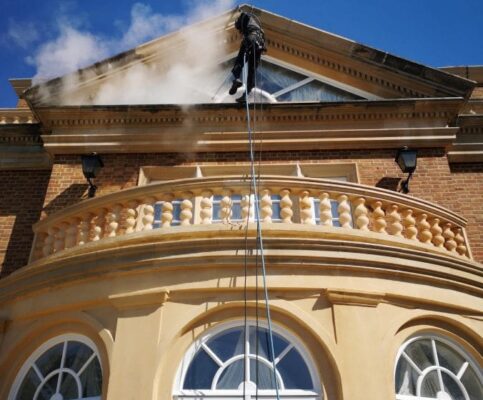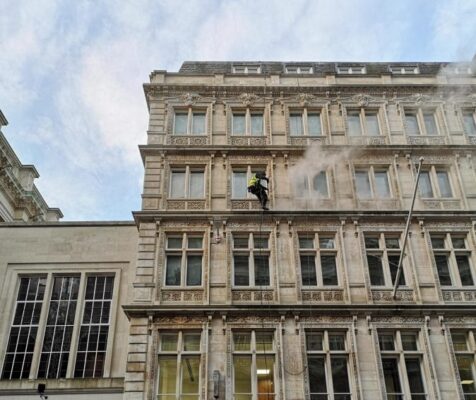View More SErvices Contact Us
Facade Cleaning in Belgravia
Cleaning building facades from top to bottom, no matter how tall your building.
Natural stone facade cleaning in Belgravia can be accessed and cleaned efficiently and effectively by using rope access methods. Using this method, the need for local authority permits is totally eradicated, allowing works to proceed immediately. Using professional stone cleaning equipment we can roll back the years to make your building look like new.
Brick cleaning
Brick buildings become dirty as much as any other building. We will not only clean away the dirt and grime, we can revitalise the colour. Using a range of bio-degradable chemicals, we can restore the colour of red or yellow bricks.
Contact UsGlass facade cleaning in Belgravia
Glass facade cleaning in Belgravia takes place by abseilers using traditional window cleaning tools. External windows, internal atriums, after builders cleaning or regular maintenance cleans, our abseilers are experienced in all manner of glass cleaning.
Contact UsAluminium cladding cleaning
Aluminium cladding in Belgravia can become extremely dirty over time. Warehouses that have many lorries coming and going will become soiled with traffic film. Using our steam cleaning systems, this grime is washed away leaving a lasting first impression for your visitors.
Contact UsOur services
Rope Access Facade Cleaning Services for Belgravia And Surrounding Counties

Residential property Stone Facade Cleaning
Façade cleaning at this residential property in Belgravia, which was not of any great height but, had no access for other forms of access equipment. Abseiling was the solution and the results were outstanding.

Stone Steam Cleaning in London
This beautiful natural stone building was looking tired from the day to day London traffic. Rope access was seen as the most cost-effective method of access.

Concrete Facade Cleaning in Belgravia
This car park in Essex was filthy. It hadn’t been cleaned, ever. As the access to three elevations was extremely tight, abseiling was the only method that could achieve the results.

Facade Cleaning in Belgravia
A new acquisition for our client needed a freshen up. Out of hours abseiling was the best way to clean this building in the heart of the City of London.
Brick colour restoration
Before colour restoration
This client requested a test patch before assigning us the job of cleaning their building. We carried this out with amazing results.
After colour restoration
These are the pictures of the test patch that we sent to the client. Her reaction was simply ‘WOW’. That’s the perfect response for us.
Torik Stone Cleaning System Features
150 degrees centigrade steam cleaning power
Provides a continues flow of superheated water to penetrate stone and deep clean, removing organic growth & ground in dirt.
We use Tensid (uk) Ltd
Providers of specialist cleaning equipment and specialist cleaning chemicals to professionals.
Get In Touch
Fill in the form below and we’ll be in touch within 24hrs of receiving your message.
Facts About Belgravia
Belgravia History
Belgravia is characterised by grand terraces of white stucco houses and is focused on Belgrave Square and Eaton Square. It was one of London’s most fashionable residential districts from its beginnings. After World War II, some of the largest houses ceased to be used as residences, or townhouses for the country gentry and aristocracy.
It was developed in the early 19th century by Richard Grosvenor, 2nd Marquess of Westminster under the direction of Thomas Cubitt, focusing on numerous grand terraces centred on Belgrave Square and Eaton Square. Much of Belgravia, known as the Grosvenor Estate, is still owned by a family property company, the Duke of Westminster’s Grosvenor Group.
General Info
Belgravia is an affluent district in Central London, shared within the authorities of both the City of Westminster and the Royal Borough of Kensington and Chelsea. Belgravia was known as Five Fields during the Middle Ages, and became a dangerous place due to highwaymen and robberies.
In the early 21st century, some houses are being reconverted to residential use, because offices in old houses are no longer as desirable as they were in the post-war decades, while the number of super-rich in London is at a high level not seen since at least 1939.



